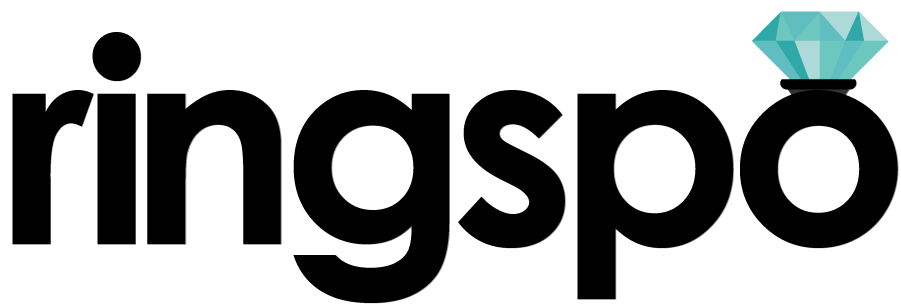Diamond Cut
The most important ‘C’
Ringspo is reader supported
Ringspo is reader-supported, which means we may receive a commission if you click a link to a retailer & subsequently make a purchase.
We feature links to several retailers to help readers find the one that is the best fit for them. Find out more about how Ringspo works here.
Diamond Cut is often highlighted as the most important ‘C’ – the one to make sure that you don’t scrimp on, because it has the biggest overall effect on the appearance of the stone. But what actually is it?
Cut is basically a measure of how well a diamond has been taken from the chunk of dull, rough diamond that is dug out of the ground (as you can see on the right), and transformed into the sparkling gem which sets female hearts-a-flutter across the world.
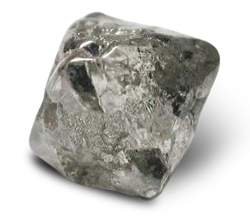
Cut is the key factor that determines affects how well light is reflected back to your eyes and therefore how brilliantly a diamond sparkles. A well cut diamond can also make a stone look larger than a poorly cut one of the same size, make the color look better and hide imperfections. So, it’s pretty important.
Cut is actually made up of three elements
- Proportion
- Symmetry
- Polish
We’ll look at each these in turn – what they really mean and what you should look out for with your engagement ring – starting with the most important.
The Perfect Proportions
There is, in theory, a perfectly proportioned round brilliant diamond. One that is mathematically perfect.
In fact, the first person to try and calculate the perfect proportion was a maths boffin. Marcel Tolkowsky published a book called ‘Diamond Design’ as part of his phD way back in 1919. In it he calculated a shape that would maximise the brilliance and fire (OK, sparkliness..) of the stone and in the process invented the round cut brilliant diamond – the most common diamond cut.
These were distilled down into a set of angles and ratios for the key parts of a diamond:
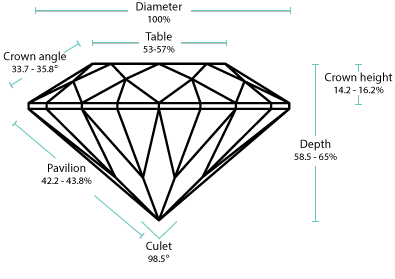
(Don’t worry, you don’t really need to remember all of these..)
Although there have been some modifications to his work over the last 95 years, his calculations still form the backbone of how we assess cut in a round brilliant diamond.
But why are these proportions so important and what happens if you stray from them? I’m glad you asked.
Too Deep
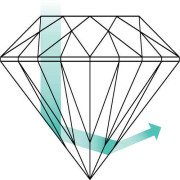
If a diamond is cut too deep the light will be reflected off the bottom of the stone at the wrong angle, rather than back to your eyes.
This will make it appear smaller from the top and can result in a dark shape appearing in the center of the stone. This is known as a ‘nailhead’.
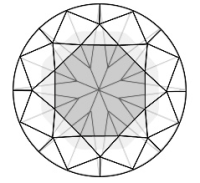
Too shallow
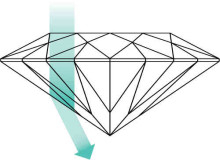
A diamond that is cut too shallow will allow more light to pass straight through it and leak out the bottom, again, making it appear less brilliant:
A shallow cut diamond can result in an effect called a ‘fisheye’, so called because a dark ring will appear on the top of the rock.
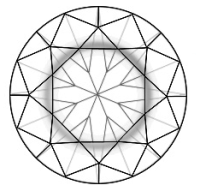
The nailhead and fisheye effect can completely ruin a stone that scores highly in all of the other diamond scoring criteria, and avoiding them is a huge reason for choosing a high cut rating.
Just right
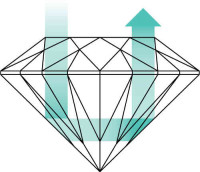
A diamond cut to ‘excellent’ or ‘ideal’ proportions will reflect as much of the light that enters the diamond back to your eyes, resulting in the incredible fire and sparkle that you want from your diamond.
Measuring Diamond Cut
Diamond cut is graded on a scale that was originally developed by the Gemological Institute of American (GIA) but is now used by pretty much everyone. It takes into account the proportions and angles in the diagram at the beginning of this section and aims to give guidance on how well each stone meets those proportions and therefore how well it should sparkle.
The scale runs from Excellent to Poor, with diamonds getting further from the ideal shape as you go down the grades:
Cut and Diamond Durability
As well as the amount that a diamond will sparkle, cut can also have an effect on a stone’s durablity. Although diamonds are harder even than an Under Siege-era Steven Seagal, they can still be damaged if they are cut to have a very fine edge or point.
Durability is mainly down to the slightly rude sounding ‘girdle’, and the less interestingly named ‘culet’.
Girdle
The girdle is the edge that runs around a diamond and is the surface that most ring settings grip onto:
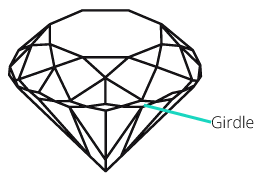
- A thin girdle can mean that the edges of the stone are more fragile, so it is more likely to chip.
- An overly thick girdle can mean that a lot of the weight of the stone is carried around its middle (a bit like a modern-day Seagal) which means that the stone will appear smaller than a well proportioned stone of the same weight.
Culet
The culet is the bottom point of a diamond, or more precisely, a lack of a point.
If the bottom of a diamond has been squared away then it’s said to have a large culet, and if it has been left as a point then it has no culet:
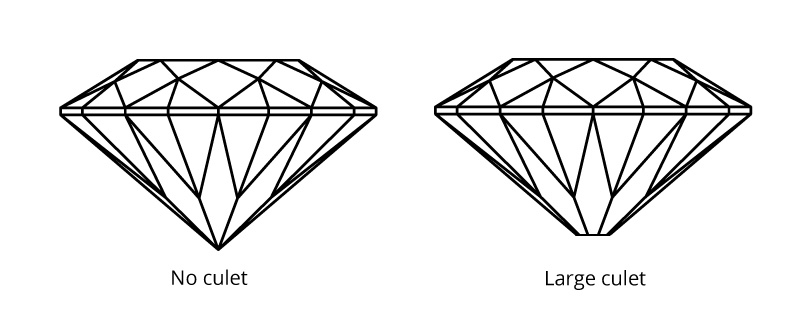
Culets are added to make the stone less likely to chip when it is being placed in the ring setting. However, a large culet could also possibly be visible when the diamond is viewed from above.
Ideally your stone’s culet should be either none / very small / small or medium. Avoid anything higher than this.
Why aren’t all diamonds excellent cut?
You might wonder why all round brilliant diamonds aren’t cut to be the best cut they can be, and the reason is because the diamond cutters can often make more money by cutting larger, but poorer quality stones.
For example, the below rough stone could either be cut to provide two diamonds that weigh 3 carats between them that have a ‘fair’ gut grade and sell for a total of $35,000, or could be cut to produce two round brilliant diamonds that weigh 2.2 carats with excellent cut grade which are only worth $20,000.
3 carats of poorly cut diamond, with minimum wastage:
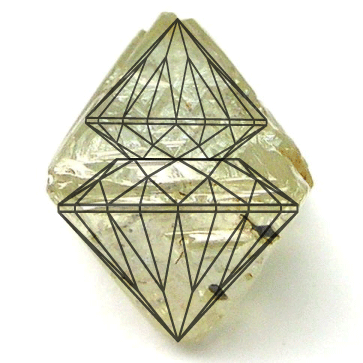
2.2 carats of ideal cut diamond, with much more wastage:
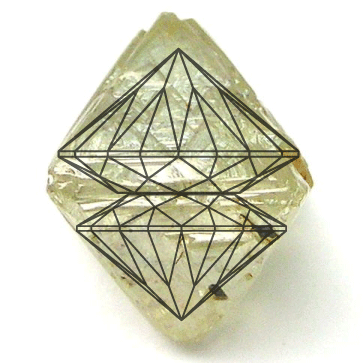
Jewelers play on people’s obsession with diamond size and ignorance of the importance of cut to maximise profit, which is pretty understandable.
But, if you don’t want to get stuck with one of the larger but poorly cut diamonds that just doesn’t sparkle, make sure you go for the highest cut grade you can.
Choosing A Cut Grade
I recommend ‘excellent’ or ‘ideal’ (the terminology sometimes changes depending on the retailer), to make sure that you get a dazzling diamond that will do your engagement ring justice.
It’s worth diverting some of your diamond budget towards the best possible cut grade you can get as it is the key determinant on how brilliant your diamond looks. A well cut stone with great fire and brilliance will make up for warmer color grades and lower clarity grades and ensure that your ring looks dazzling.
Avoid ‘poor’ cut diamonds at all costs – even if it does mean that your budget can now stretch to a 3 carat stone, it will look dull and lifeless and the compromise isn’t worth it.
Diamond symmetry
A diamond’s symmetry is a measure of how well proportioned the different facets of a stone are in relation to each other – basically how well the different parts of the stone line up.
It’s an important factor because a stone with poor symmetry may bounce light off at odd angles, reducing the amount that is reflected to your eye and therefore reducing the sparkle.
There are a few ways that a stone can be asymmetrical:
Top table (flat area at top) is off-center:
‘Culet’ is off-center (tip at bottom of diamond):
Girdle is uneven and diamonds is not perfectly round:
Girdle is not straight all the way around:
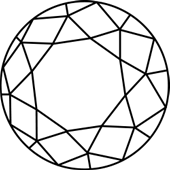
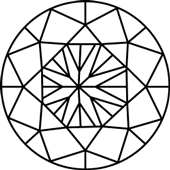
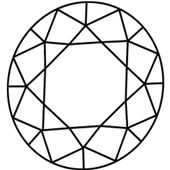
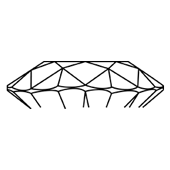
Like the general cut grade, symmetry is graded from ‘Excellent’ to ‘Poor’. But unlike the general cut grade, symmetry makes much less difference to how much a diamond sparkles and how impressive it is.
Choosing excellent to good means that your stone will appear absolutely perfect to the naked eye and will not affect the light performance of your stone. Avoid diamonds graded ‘Poor’, as these stones will have errors in symmetry that are noticeable to the naked eye.
Although it doesn’t make a difference to appearance of a stone, choosing ‘excellent’ symmetry rather than ‘good’ can make a large difference to the price – about 10% – 15%. As with everything as you get towards the upper reaches of diamond quality, this is because of the perceived value of ‘excellent’ grades, rather than any actual visible effect.
Symmetry shouldn’t be a prime factor in choosing your stone, but if you are comparing two diamonds that otherwise appear to be equal in other factors e.g. clarity and colour, and you’re not sure which one to choose then symmetry could be the tie-breaker.
Hearts and Arrows
Hearts and Arrows
‘Heart and arrows’ is a term given to diamonds that take symmetry to its limit, resulting in an extremely regular series of shapes that can be seen when the diamond is viewed through a special viewer (right), which uses coloured filters to show how light is reflected by a diamond.
The filters on the viewer give a colour to the stone, with light that is emitted and will appear as sparkles appearing as red, and dark areas showing where light is traveling through the diamond, and ‘leaking’ out of the bottom.
All diamonds have some degree of light leakage, but through examining the patterns of light leakage you can see how symmetrical a stone is.
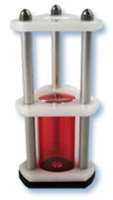
Viewed from the bottom:

In a perfect hearts and arrows stone, the facets angles combine that the light that leaks through forms 8 hearts around the diamond.
Getting this level of cut accuracy and consistency for each of the facets is extremely difficult and shows great skill on the behalf of the diamond cutter.
Viewed from the top:

The corresponding arrows that can be seen when a diamond is viewed through the viewer.
It’s impossible to see these any other time other than when the specialized viewer is used.
Hearts and arrows may be used as a big selling point if you’re looking at a diamond, and they are nice to have, but they’re definitely not essential. Blind tests where people are asked to judge how much a stone sparkles, have shown that there is no difference between a stone that has hearts and arrows and one that doesn’t.
More care is definitely needed to create them, so hearts and arrows is an indicator that generally the cut will be good cut. But it doesn’t necessarily mean that the stone will sparkle brightly. A stone with perfect hearts and arrows could actually have poor proportions, which would mean that any benefit from the excellent symmetry will be completely eradicated. Never substitute hearts and arrows for good proportions.
Diamond Polish
Diamonds’ facets are added by specialists who have quite possibly the most awesome job title in the world – ‘Brillianteers’. It’s like they are a team of sidekicks to a really shiny super hero or something – Captain Chromenuts and the Brillianteers.
Brillianteers create and polish the facets using a a spinning wheel made of iron:
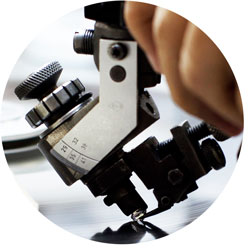
The diamonds are held against the wheel and mixture of diamond dust and olive oil (honestly!) are used to gradually polish each side of the stone. Creating just one facet can take several hours (there are 57 facets in a round brilliant diamond).
Sometimes though, Brillianteers are, well, less brilliant. While polishing a stone, they sometimes leave marks on the surface of the diamond, which can affect the amount of light that passes through them.
Polish lines: White lines that appear from the polishing process
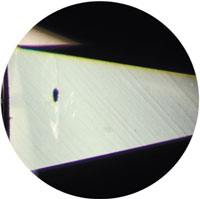
Lizard skin: Caused by polishing a diamond against the grain
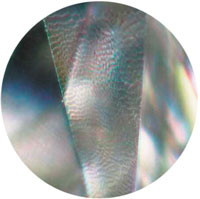
Abrasion: Tiny marks that can appear when a diamond is knocked
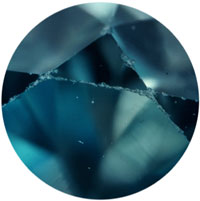
These marks are usually so small that they can be discounted and don’t affect the way that the diamond reflects light or the stone sparkles unless you go for a very low grade.
Like with diamond cut and symmetry, diamond polish is graded from Excellent to poor. And, like with symmetry, with diamond polish you can choose Excellent, Very Good or Good on the polish scale and be sure that your stone will sparkle brilliantly. Avoid any that are graded as fair or poor to ensure that any polish imperfections don’t affect your stone’s brilliance.
How important is cut, really?
Hopefully in this post you have seen the different ways that cut can affect the appearance of a diamond and the big effect it has on how a stone reflects light, the amount it sparkles and how impressive your engagement ring is.
Some people prioritise the size of their diamond over the ‘optical performance’ of the stone, but this is a sure-fire way to get a big rock that actually looks dull. A big stone that doesn’t actually do what it should is the ostrich of the diamond world. A big useless lump. Sorry evolution, but that was a bad one.
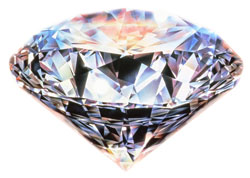

Earlier on this page I recommended only ‘excellent’ stones and I would definitely stick by this. If your budget can’t stretch to excellent for the size of stone that you want, then I’d recommend going slightly smaller on the carat size and increasing the cut grade – it really will make a difference to how much light is reflected, how much it sparkles and how impressive the ring is.
Very good is still acceptable, but my strong recommendation is to avoid anything lower than that. A huge diamond that is dull and lifeless won’t impress anyone.
Symmetry and polish have less affect on the appearance of a stone than the proportion of it, but they can still have a significant affect on the price you pay. A stone with excellent symmetry and polish can be 10-15% higher than one that only ranks ‘good’ in these areas. The difference is because retailers know that consumers are prepared to pay a premium for a stone to be as close as possible to perfect, rather than any actual affect on the way that it looks.
Have a play with the different variables of the stones one of my recommended retailers and see how it affects the price you pay. You might be surprised at how reducing the size only slightly will allow you to bump up the clarity to an excellent cut grading. And if you can do that then your diamond will look more brilliant and your ring will be much, much more impressive.
Learn about the rest of the 4Cs

Carat
Find out why biggest isn’t always best

Clarity
How to avoid paying over the odds

Color
Make sure it makes a difference
